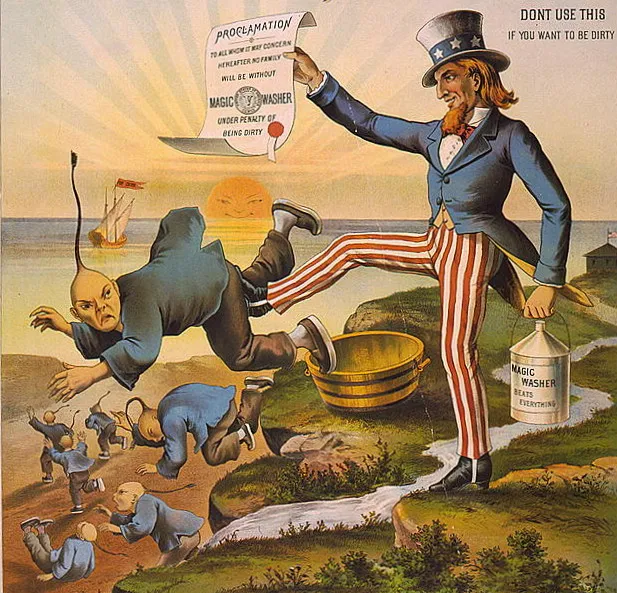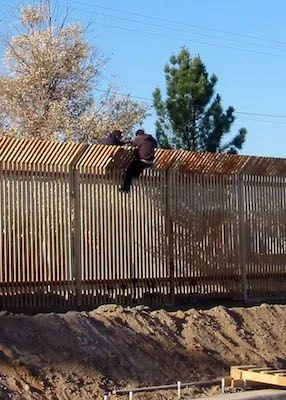
- Use and Abuse
The United States of America greeted many of its immigrants with open arms during the great expansion of the country in the 1800's. The U.S. was a growing nation then, industrialized yet still seeking to connect its two coasts via the U.S. railroad. Then the California Gold Rush hit in the late 1840's, and immigrants from all over the world poured into the U.S., in particularly California and the West.
It was during this time that many Chinese men made the long journey to America, seeking work that would allow many to maintain a household back in China. They came to build the railroad and to mine California Gold. Many other immigrants from other parts of the world also came and contributed during this time of great expansion.
Yet, it would only be the Chinese that would be targeted once the good times stopped. After most of the major railroads had been built, and most of the Gold had been dug up came harder times for the U.S. The U.S. Civil War had ended mid 1865, and by the 1870's, the U.S. was in an economic down turn. It was during these times that the sentiment towards immigrants turned from a welcoming one to one of disdain. This wave of anti-immigrant hit the Chinese particularly hard, with many blaming the Chinese for the harsh economic times of the day. By 1882, Congress had enacted the Chinese Exclusion Act which basically made it illegal for any Chinese person to legally emigrate into the United States. This act would keep many Chinese families apart for years if not permanently.
It would be this act, the Chinese Exclusion Act of 1882, that would springboard illegal immigration and the smuggling trade of undocumented people, particularly through Mexico. Since hundred of thousands of Chinese had already legally emigrated and made life in the United States, this new law kept many from reuniting with family and loved ones. The Exclusion Act of 1882 basically barred anyone from China legally entering the U.S. for ten years. For many that was unfair and too long to have to wait to have their families with them.
This Chinese exclusion Act drove those desperate for family and loved ones to smuggle their families in to the U.S. During this time there was no official U.S. Immigration Department that guarded the borders. This allowed the Chinese to use Mexico and Canada as smuggling routes to bring their loved ones to America. The wave of illegal Chinese immigrants from both the northern and southern border eventually led to a build up of U.S. border protection in order to prevent the mostly Chinese immigrants.
This anti-immigrant political wave of the late 1800's rolled on in to the early 1900's. It culminated with the U.S. Immigration Act of 1924 which was enacted to mostly restrict immigration of Chinese and other Asians, as well as Eastern and Southern Europeans while also banning East Indians and Arabs. Ironically, it exempted Mexicans from this list of excluded migrants since Mexicans are considered Native American with (Northern) European (White) blood. Thus Northern Europeans, Whites and Mexicans could legally migrate to the U.S. even after the Immigration Act of 1924.
But the love for the Mexican immigrant would last only as long as the economic good times rolled as was the case with the Chinese. The depression of 1929 quickly put an end to the romance between the U.S. economy and the Mexican migrants. After 1929, Mexicans and people of Mexican descent were no longer needed nor welcomed in the United States, and immigration enforcement against immigrants became the norm then and since. America's unofficial open borders policy officially ended during this time.
Although the borders have become increasingly policed and secured since the Immigration Act of 1924, America's love affair with cheap illegal immigrant labor seems more like an addiction. In the mid 1960's, U.S. immigration policy once again favored Mexican immigrants with favorable policies geared towards uniting U.S. residents with family abroad by allowing them to emigrate into the U.S.
This love / hate relationship with immigrants has been on going for well over 100 hundreds years. Everything is fine and dandy when the economic times are good, and cheap labor is in demand. Then, immigrants seeking a better life are welcomed to slave away under America's Corporate profit machines for the Wealthy. The love affair quickly ends in scape goating, or maybe in today's modern version of breaking up called ghosting when the economic good times end. Under Donald Trump, this soured relationship is going to end up with a supposed 2,000 mile long fence/wall.
If history teaches us anything, it is that people will always find a way when desperate enough. In the late 1880's, the Chinese used the Canadian border as well as the Mexican border to illegally cross into the United States. So if and when Trump's wall is put up on the Southern U.S. border, will he then be prepared to place one on the U.S. Canadian Border as well? Should the East Coast and West Coast get walled up too? Then will Trump be prepared to dig deep around those walls and cement the tunnels too?

Is there a better question with a better answer?
Would spending the Billions needed for the Wall/s be better used to economically boost repressed and depressed economic regions, thus creating a better quality of life and stemming the flow of immigration?
It seems to me that building a wall just leads to people going around, over, under and through it. With the U.S.'s low unemployment rate of 3.9%, it just might not make sense to wall the U.S. in, when it might be looking for outside labor like it has in the past..... only to boot them when done with them?
Full Steem Ahead!
@streetstyle
Sources:
https://en.wikipedia.org/wiki/Chinese_Exclusion_Act
http://www.worldstir.com/history-u-s-mexico-border-wall/
https://en.wikipedia.org/wiki/Mexico%E2%80%93United_States_barrier
https://timeline.com/mexican-border-chinese-wall-62bda038c29a
https://faculty.utep.edu/LinkClick.aspx?link=Lee.pdf&tabid=68749&mid=158529
https://en.wikipedia.org/wiki/Immigration_Act_of_1924